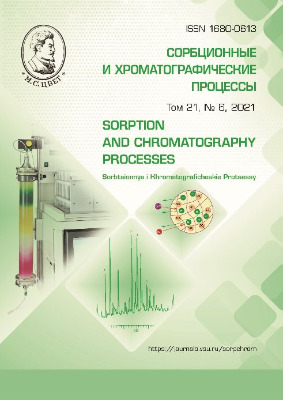Selective analysis of ozone with PdO semiconductor sensors in thermal modulation mode
Abstract
The study is devoted to the problem of ozone detection by semiconductor gas sensors. Ozone is widely used in various technological processes, but it is an extremely poisonous gas. This determines the relevance of the presented study. The new gas sensor material - PdO is discussed in the study. The aim of this study was to increase the selectivity of ozone analysis using PdO semiconductor sensors operating in thermal modulation mode. Thin PdO films with a thickness of 30 nm were used in this study. Their resistive response in ozone in a mode of variable temperature change according to a sinusoidal law in the range of 50-30-50оС was investigated. The use of thermal modulation allowed to reveal extrema in the dependence of electrical resistance on time in the presence of ozone, providing the possibility of selective detection. A possible mechanism of ozone chemisorption was considered, which determined the specific form of the thermomodulated response of PdO. Similar comparative gas sensor experiments with nitrogen oxide, an oxidizing gas similar in properties, have been carried out. Significant differences in the shape of the resistive response of the sensor in these two gases have been revealed, indicating that PdO sensor is selective in detecting ozone and nitric oxide (IV) in the thermal modulation mode.
Downloads
References
Korotcenkov G., Brinzari V., Cho B.K., Journal of Sensors, 2016, Vol. 2016, Article ID 3816094, pp. 1-31. DOI: https://dx.doi.org/10.1155/2016/3816094
Takada Tadashi, Tanjou Hiromasa, Saito Tatsuo, Harada Kenji, Sensors and Actuators B, 1995, Vol. 25, No 1-3, pp. 548-551.
Obvintseva L.A., Sharova T.B., Avetisov A.K., Sukhareva I.P., Russian Journal of Physical Chemistry A, 2018, Vol. 92, No 6, pp.1099-1106. DOI: https://10.1134/S0036024418060122
Shaposhnik A., Moskalev P., Sizask E., Ryabtsev S. et al., Sensors, 2019, Vol. 19, pp. 1135-1149. DOI: https://10.3390/s19051135.
Shaposhnik A.V., Moskalev P.V., Chegereva K.L., Zviagin A.A. et al., Sensors & Actuators: B. Chemical, 2021, Vol. 334, p. 129376. DOI: https://org/10.1016/j.snb.2020.129376.
Ryabtsev S.V., Ievlev V.M., Samoylov A.M., Kuschev S.B. et al., Thin Solid Films, 2017, Vol. 636, pp.751-759. DOI: https://10.1016/j.tsf.2017.04.009
Ryabtsev S.V., Shaposhnik A.V., Samoylov A.M., Sinelnikov A.A. et al., Doklady Physical Chemistry, 2016, Vol. 470, pp.158-161. DOI: https://10.1134/S0012501616100055
Ievlev V.M., Ryabtsev S.V., Samoylov A.M., Shaposhnik A.V. et al., Sensor and Actuators B, 2018, Vol. 255, No 2, pp.1335-1342. DOI: https://10.1016/j.snb.2017.08.121
Ryabtsev S.V., Ghareeb D.A.A., Sinelnikov A.A., Turishchev S.Yu. et al., Kondensi-rovannye sredy i mezhfaznye granitsy, 2021, 23(1), pp. 56-61. DOI: https://10.17308/kcmf.2021.23/3303
Chizhov A., Rumyantseva M., Vasiliev R., Filatova D. et al., Thin Solid Films, 2016, Vol. 618, pp. 253-262. DOI: https://10.1016/j.tsf.2016.09.029







